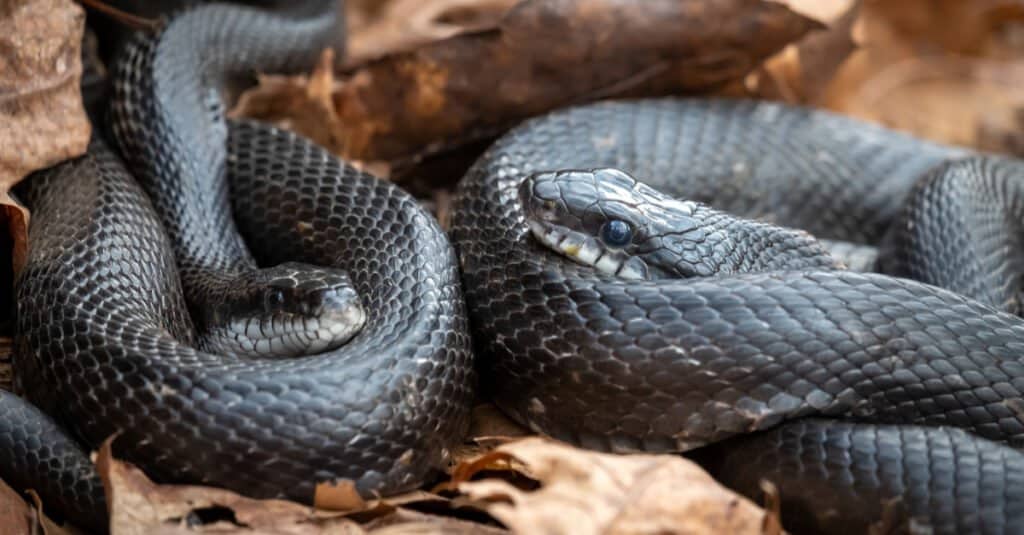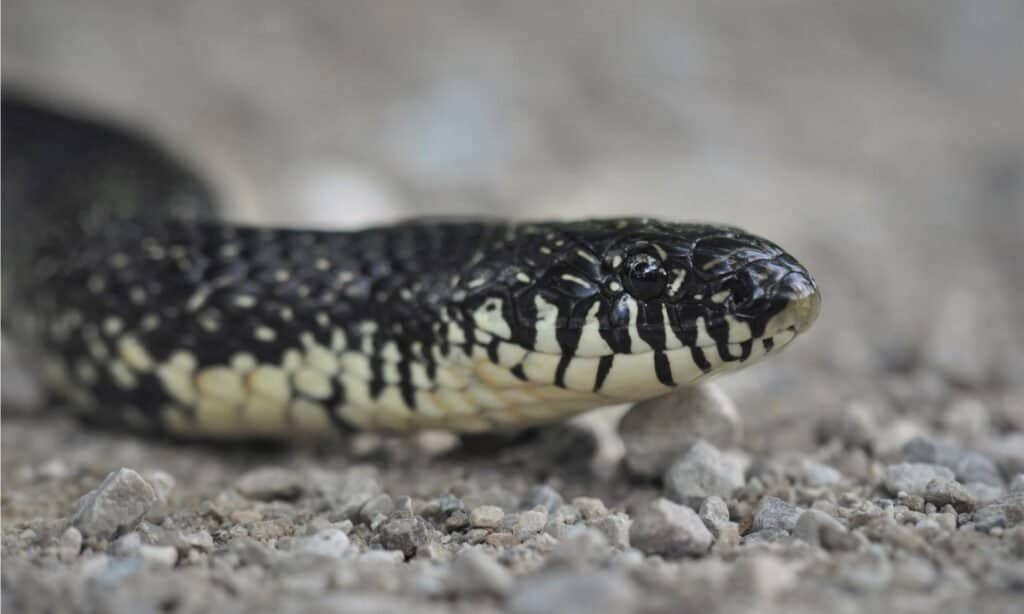Identifying snakes isn’t always easy, especially when they have really basic colors. During the spring and summer, the likelihood of encountering a snake goes up, and knowing which ones are dangerous is important! Today, we are going to be taking a look at the most common snakes in the US that are black with white bellies. By the end, you should be able to identify almost any black snake with a white belly and tell if it’s safe or not!
Where Do Black Snakes With White Bellies Live?
There are over 3,000 species of snake across the world, and they all come in an array of colors and patterns. Covering every black snake that had white on its belly is quite a task, so we narrowed our list today to snakes that can be found in the United States.
Although most of these snakes are found in the eastern US, a few of them have subspecies that can be found across most of the country. For each snake, we will cover the following to help you identify it:
- A basic description
- Their range and distribution
- Their preferred habitat
With those bits of information, you should be set to identify any black snakes with white bellies you encounter this year! Let’s get started.
Nonvenomous Black Snakes With White Bellies
This is our list of nonvenomous snakes that are black with white bellies. If you see one of these snakes, you don’t have to worry about your safety. Additionally, you don’t have to worry about killing these snakes out of fear, as that could actually harm the ecological niche that they live within.
Black Rat Snake

Black rat snakes are common snakes with shiny black bodies and white underbellies.
©samray/Shutterstock.com
The black rat snake goes by many names, including the black chicken snake, black Coluber, black pilot snake, and the eastern black rat snake. They are some of the most common snakes in the eastern United States, and most people have encountered them at least once in their lives.
Physical description: The black rat snake can vary in color depending on where it is found. When people refer to a “black rat snake,” they generally refer to a specific variation of the eastern ratsnake that happens to be totally black in color. This specific variation can be up to 6 feet in length and has a shiny black body with a white or cream belly. Their bellies are occasionally checkered in black and white.
In other variations, these snakes can be striped and come in shades of gray, black, and even orange (in Florida).
Distribution: The eastern ratsnake can be found from Texas to Florida and up into the Great Lakes region and New England. The black rat snake color variation has a more northerly range, however, and can be found within the same range, just north of Florida and Louisiana.
Preferred habitat: Black rat snakes aren’t picky when it comes to habitat. They can be found in yards, suburbs, fields, pine forests, and almost everywhere else. They are extremely common.
Black Racer

The black racer is another common snake with a black body. It often has a white chin and a lighter belly.
©Breck P. Kent/Shutterstock.com
The black racer is another common snake in the eastern US, with multiple recognized subspecies across their range. The southern black racer is most likely to fit the description of a black body and white belly, however.
Physical description: The southern black racer is a thin snake known for its incredible speed (hence the name). They are flat black and can reach lengths of 6 feet but are much smaller in girth than the ratsnake. They can come in shades of gray or black and have throats that can be white or cream. Their bellies are usually a lighter shade than their backs and can vary from cream to various shades of yellow.
Distribution: The racer can be found across the entirety of the eastern United States. Southern black racers inhabit a smaller range within this range and can be found in the southeast up into Kentucky, Tennessee, and west into Arkansas.
Preferred habitat: These snakes are generalists and can be found in forests, swamps, and even in the Florida Everglades. You are likely to encounter cruising through yards while they periscope up in longer grasses.
Eastern Kingsnake

The Eastern kingsnake comes in many variations, most of which are black and white.
©Mike Wilhelm/Shutterstock.com
The eastern kingsnake is less common than the black racer and rat snake but is widespread across much of the eastern US. Another variation, known as the California kingsnake, lives along the west coast and comes in a few more colorations than its east coast relative. Within the eastern kingsnake family are multiple variations, including the black kingsnake and the speckled kingsnake.
Physical description: Eastern kingsnakes are thicker black snakes with white banding that reaches from their head to their tails. The thickness of the banding reflects their environment, with coastal populations having wider bands and mountainous populations having thicker ones. Black kingsnakes are almost totally black and have spidery thin bands that aren’t nearly as distinct, while speckled kingsnakes are speckled. All eastern kingsnakes are black and white with a white belly, while the western kingsnake can come in shades of red, brown, or cream.
Distribution: Eastern kingsnakes live across the entirety of the eastern United States and as far north as New Jersey.
Preferred habitat: The preferred habitat of the eastern kingsnake includes forests, swamps, tidal regions, and more. They are almost always found near water, however, and spend much of their time hidden under objects.
Venomous Black Snakes With White Bellies
There aren’t many black snakes with white bellies in the United States that are venomous. In fact, there is really only one snake that fits the description. It’s important to remember that although a snake can be dangerous, they are openly aggressive toward humans unless provoked or intruded upon. Killing a snake should always be a last resort and not done simply on principle.
Cottonmouth

Cottonmouths are venomous snakes with black, gray, or brown bodies with lighter bellies.
©Marcum Havens/Shutterstock.com
The cottonmouth is the only semiaquatic pit viper that can be found across much of the eastern United States. There are a few subspecies of cottonmouth across the range, including the western cottonmouth, Florida cottonmouth, and eastern cottonmouth. Common names for the cottonmouth include water moccasin, swamp moccasin, black moccasin, and gaper. These snakes get their name from their white mouths, which are flashed in defense when a predator gets too close.
Physical description: The cottonmouth is a thick, broad snake that can grow to about 4 feet in length. They come in shades of black, gray, and olive with crossbands that appear washed or absent altogether. Their scales are heavily keeled, and their eyes have a catlike slit. As a pit-viper, these snakes have a distinct heat-sensing pit visible between their nose and eyes on either side.
Distribution: Cottonmouths can be found in the southeastern United States, from central Texas to Florida and as far north as Illinois and Virginia.
Preferred habitat: The cottonmouth is an aquatic snake and is almost always found around water. They prefer swamps, marshes, floodplains, and wetlands of all types.
The photo featured at the top of this post is © Rusty Dodson/Shutterstock.com
Discover the "Monster" Snake 5X Bigger than an Anaconda
Every day A-Z Animals sends out some of the most incredible facts in the world from our free newsletter. Want to discover the 10 most beautiful snakes in the world, a "snake island" where you're never more than 3 feet from danger, or a "monster" snake 5X larger than an anaconda? Then sign up right now and you'll start receiving our daily newsletter absolutely free.
Thank you for reading! Have some feedback for us? Contact the AZ Animals editorial team.






